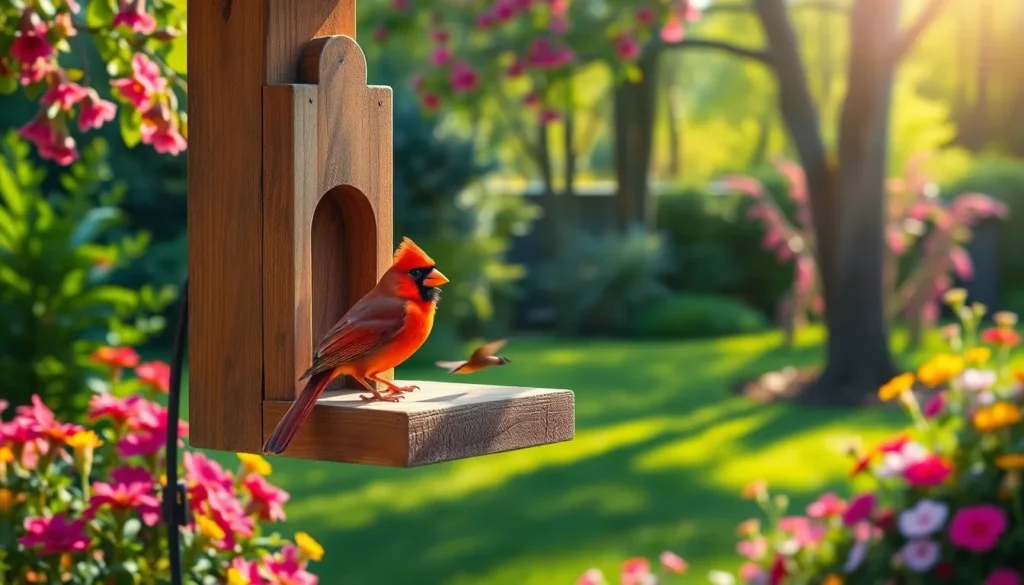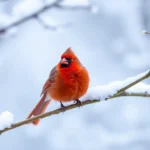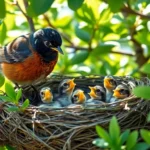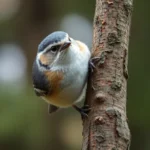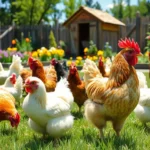When we step outside and hear the morning chorus of chirping birds, we’re experiencing one of nature’s most diverse spectacles. With over 10,000 bird species worldwide, these fascinating creatures have adapted to virtually every environment on Earth – from tropical rainforests to arctic tundra.
We’ve all wondered about the different birds we see in our backyards or during nature walks. Some soar majestically overhead while others hop playfully through garden bushes. Understanding bird types isn’t just for birdwatchers – it connects us to the incredible biodiversity surrounding us every day.
Whether you’re curious about identifying that colorful visitor at your bird feeder or planning your first birdwatching adventure, knowing the main categories of birds opens up a whole new industry of appreciation for wildlife. From tiny hummingbirds that beat their wings 80 times per second to massive eagles with eight-foot wingspans, each bird type has evolved remarkable characteristics that make them perfectly suited for their unique lifestyle.
Common Backyard Bird Types Every Bird Watcher Should Know
Starting with familiar species helps build confidence and identification skills for any birdwatching journey. We’ve selected three of the most recognizable backyard visitors that offer excellent learning opportunities for beginners.
Cardinals and Their Vibrant Red Plumage
Cardinals stand out as one of North America’s most beloved backyard birds. Males display brilliant crimson feathers from head to tail, while females showcase warm brown tones with reddish tinges on their wings, tail, and crest. Both sexes feature the characteristic thick, orange-red beak that’s perfectly designed for cracking seeds.
These year-round residents prefer dense shrubs and woodland edges. Cardinals don’t migrate, so we can spot them in our backyards throughout all seasons. They’re particularly active during early morning and late afternoon hours.
Feeding habits make cardinals easy to attract and observe. Sunflower seeds, safflower seeds, and cracked corn draw them to feeders consistently. Cardinals prefer platform feeders or large tube feeders where they can perch comfortably while eating.
Blue Jays and Their Distinctive Calls
Blue Jays command attention with their striking blue, white, and black coloration. Their vibrant blue wings and tail feathers contrast beautifully with their white chest and distinctive black necklace marking. These intelligent corvids also sport a prominent blue crest they can raise or lower depending on their mood.
Vocalizations make Blue Jays unmistakable among backyard birds. Their loud “jay-jay-jay” call carries across neighborhoods, but they can also produce over 100 different sounds. Blue Jays often mimic the calls of hawks, particularly Red-shouldered Hawks, to scare other birds away from food sources.
Intelligence levels in Blue Jays rival those of many mammals. These clever birds cache thousands of acorns each fall, remembering the locations months later. They’ll also use tools occasionally and can recognize themselves in mirrors, demonstrating remarkable cognitive abilities.
Social behaviors create fascinating viewing opportunities. Blue Jays travel in family groups and communicate constantly with various calls and body language. During breeding season, males perform elaborate courtship displays and both parents work together to defend their territory aggressively.
American Robins and Their Seasonal Patterns
American Robins serve as reliable indicators of seasonal changes. These medium-sized thrushes feature distinctive orange-red breasts, dark gray heads, and lighter gray backs. Males typically display deeper, more vibrant orange coloring compared to females.
Migration patterns vary significantly across different regions. Northern populations migrate south for winter, while southern robins may remain year-round residents. We often see the first returning robins in late winter or early spring, making them traditional harbingers of warmer weather.
Feeding behaviors change dramatically with the seasons. Spring and summer robins hunt earthworms on lawns, using their keen eyesight to spot movement in the grass. Winter diets shift to berries and fruits, bringing robins to trees and shrubs loaded with mountain ash, sumac, or crabapples.
Nesting activities provide excellent observation opportunities. Female robins build cup-shaped nests using mud, grass, and twigs in trees, shrubs, or even on building ledges. They typically raise two to three broods per year, with bright blue eggs that hatch after about two weeks of incubation.
Majestic Birds of Prey Types Found Across North America
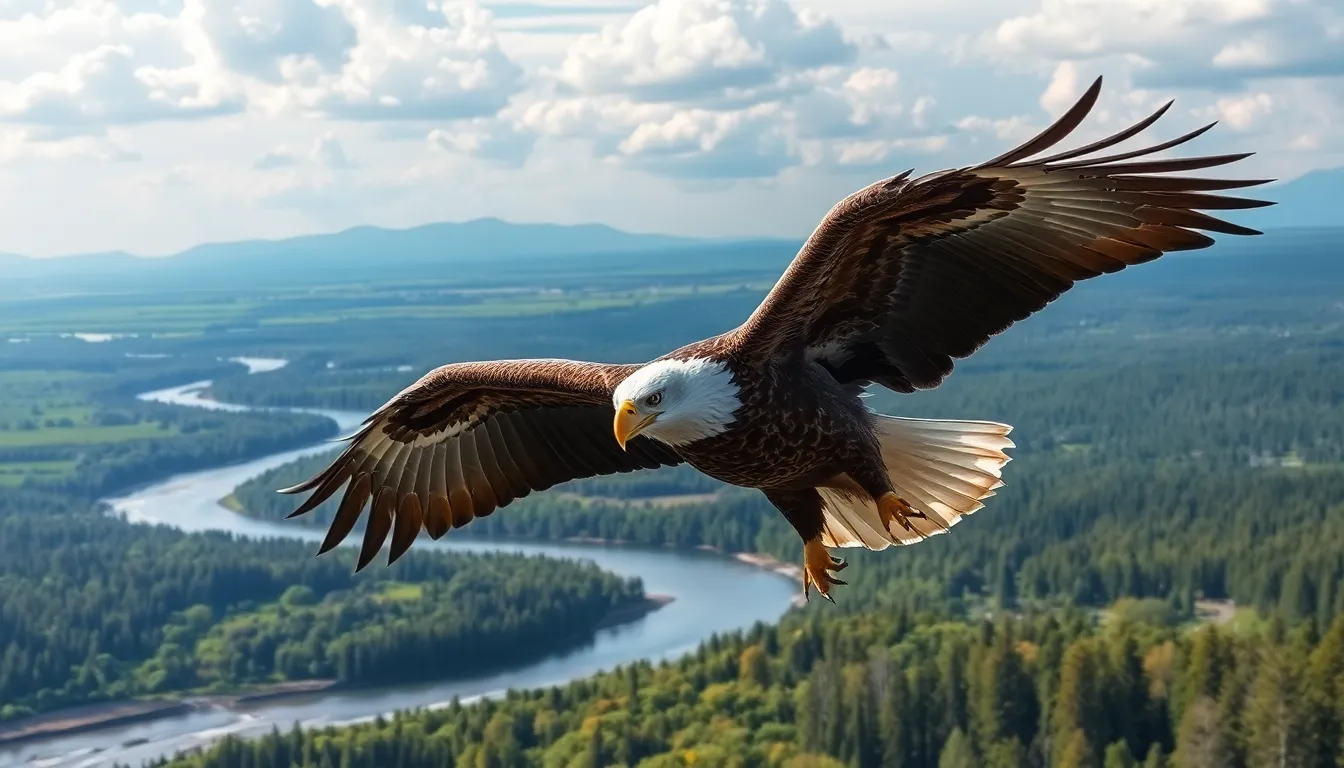
North American raptors command respect through their powerful builds and exceptional hunting abilities. We’ll explore three dominant groups that rule different ecological niches across the continent.
Eagles and Their Impressive Wingspans
Bald Eagles soar with wingspans reaching 7.5 feet and serve as America’s national symbol through their remarkable recovery from near extinction. These magnificent raptors prefer waterways where they hunt fish, waterfowl, and small mammals with their powerful talons. We observe them building enormous nests that can weigh over a ton after years of additions.
Golden Eagles dominate mountainous regions with slightly smaller wingspans of 6 to 7.5 feet but possess incredible speed during hunting dives. Their brown and gold plumage provides perfect camouflage against rocky terrain where they nest on cliff faces. Hunters prize these eagles for their ability to take prey as large as young deer and mountain goats.
White-tailed Eagles occasionally appear in Alaska with the largest wingspans among North American eagles at up to 8 feet. European populations have established small footholds in the Aleutian Islands where they compete with Bald Eagles for fishing territories.
Hawks and Their Hunting Techniques
Red-tailed Hawks employ soar and glide techniques from elevated perches before swooping down on rodents, rabbits, and snakes across diverse habitats. These adaptable raptors thrive in both urban and rural environments by adjusting their hunting strategies to available prey. We recognize them by their distinctive rust colored tail feathers and piercing calls that echo across open landscapes.
Cooper’s Hawks specialize in high-speed pursuits through dense forests where they chase songbirds and small mammals with remarkable agility. Their short rounded wings and long tails provide exceptional maneuverability between trees and shrubs. Backyard bird feeders often attract these hawks as they follow their prey into residential areas.
Sharp-shinned Hawks mirror Cooper’s Hawks in hunting style but target smaller prey including finches, sparrows, and thrushes with lightning fast attacks. These compact raptors weigh only 3 to 8 ounces yet demonstrate incredible precision when handling through thick vegetation. Migration seasons bring large numbers through mountain passes and along coastlines.
Owls and Their Nocturnal Behaviors
Great Horned Owls hunt during twilight and darkness using exceptional hearing and silent flight to locate mammals, birds, and reptiles across varied territories. Their distinctive ear tufts aren’t actually ears but feathers that help with camouflage and communication. We find these powerful owls nesting in abandoned hawk nests, tree cavities, and even urban structures.
Barn Owls patrol agricultural areas and grasslands where their heart shaped facial discs funnel sound waves to asymmetrically placed ears for pinpoint prey location. Their ghostly white appearance and eerie calls have inspired folklore across cultures for centuries. Farmers welcome these owls because a single family consumes thousands of rodents annually.
Screech Owls demonstrate remarkable camouflage abilities by pressing against tree trunks where their mottled plumage blends perfectly with bark patterns. These small owls produce haunting calls that sound more like horses whinnying than traditional hooting. Urban parks and wooded suburbs provide ideal habitat for these adaptable nocturnal hunters.
Colorful Songbird Types That Brighten Your Garden
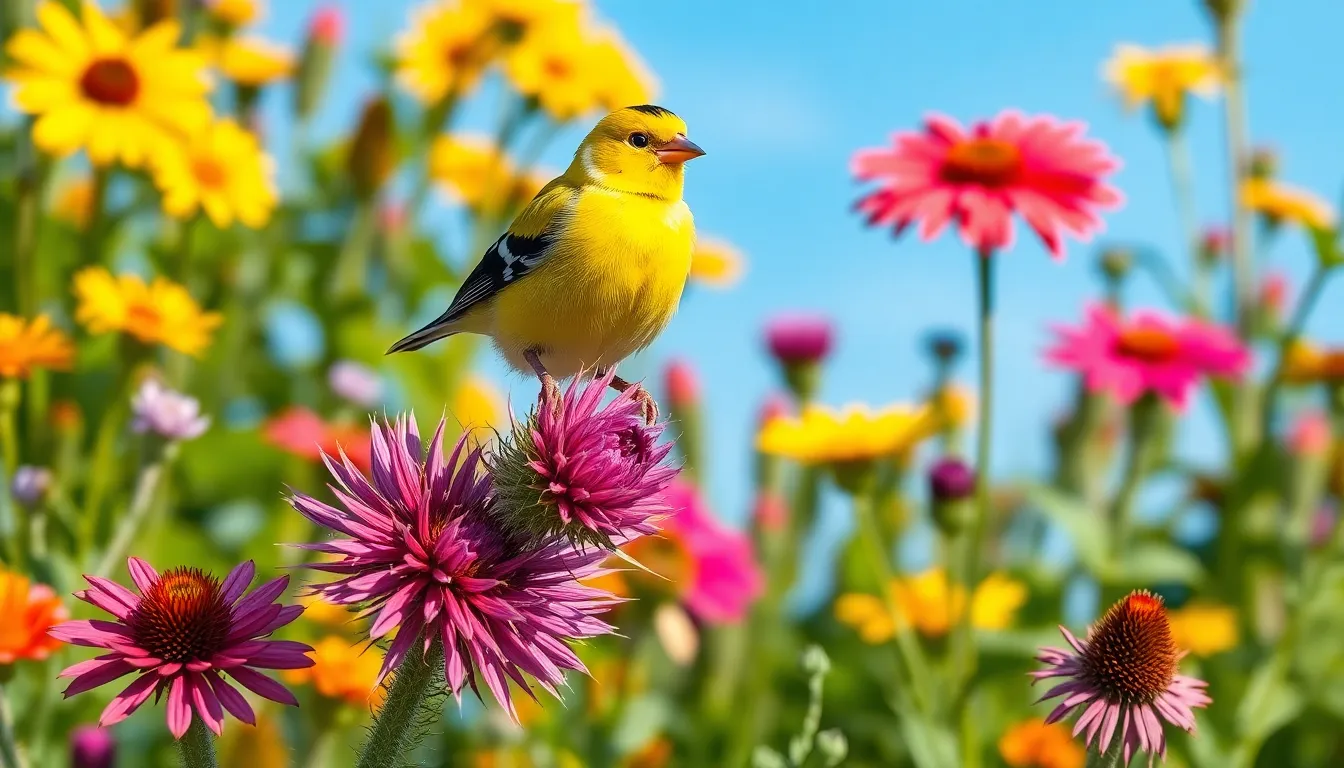
Beyond the common backyard birds we’ve explored, colorful songbirds add vibrancy and musical charm to outdoor spaces throughout North America. These species offer visual beauty and enchanting melodies that transform gardens into natural sanctuaries.
Goldfinches and Their Seasonal Color Changes
Goldfinches undergo remarkable transformations that make them living calendars in our gardens. Males develop brilliant yellow plumage during breeding season from April through August, contrasting sharply with their olive brown winter appearance. Females maintain subtler coloring year round with pale yellow undertones and darker wing markings.
American Goldfinches prefer thistle seeds and nyjer feeders, often appearing in flocks of 10-20 birds during peak feeding times. Their undulating flight pattern creates distinctive waves as they call “po-ta-to-chip” while moving between food sources. Lesser Goldfinches inhabit western regions and retain more consistent coloring, with males showing black caps and bright yellow bodies throughout most seasons.
These acrobatic feeders cling to seed heads upside down, demonstrating flexibility that larger birds can’t match. Peak breeding occurs from June through September when abundant seeds support their late nesting cycle.
Bluebirds and Their Nesting Preferences
Bluebirds represent success stories in conservation, with populations recovering significantly since the 1970s through targeted nest box programs. Eastern Bluebirds prefer open areas with scattered perches, including golf courses, parks, and rural properties with maintained grass areas. Males display vibrant blue backs and rusty orange breasts while females show grayish blue tones with warm buff coloring.
Western Bluebirds inhabit oak woodlands and burned areas where insect populations thrive. Mountain Bluebirds occupy higher elevations and open country, with males showing pure blue coloration without orange markings.
Proper nest box placement requires mounting heights of 4-6 feet with entrance holes measuring 1.5 inches in diameter. Spacing boxes 100 yards apart prevents territorial conflicts while providing adequate hunting territory for each pair. These cavity nesters prefer boxes facing away from prevailing winds and afternoon sun exposure.
Wrens and Their Melodic Songs
Wrens compensate for their small size with outsized vocal abilities that fill gardens with complex melodies. House Wrens deliver cascading songs that can include over 100 different notes in sequences lasting 2-3 seconds. Their brown coloring provides excellent camouflage while they forage through brush piles and dense vegetation.
Carolina Wrens produce loud, ringing calls that carry important distances even though the bird’s compact 0.7-ounce weight. These non-migratory residents maintain territories year round and often sing duets between mated pairs. Winter Wrens offer surprisingly powerful voices for their tiny frames, creating songs with rapid trills that can last 8-10 seconds.
Natural nesting sites include brush piles, old shoes, flower pots, and any cavity that provides protection from predators. Wrens consume impressive quantities of insects, with single birds eating over 500 beetle larvae, caterpillars, and spiders daily during breeding season.
Waterfowl Bird Types Living Near Lakes and Rivers
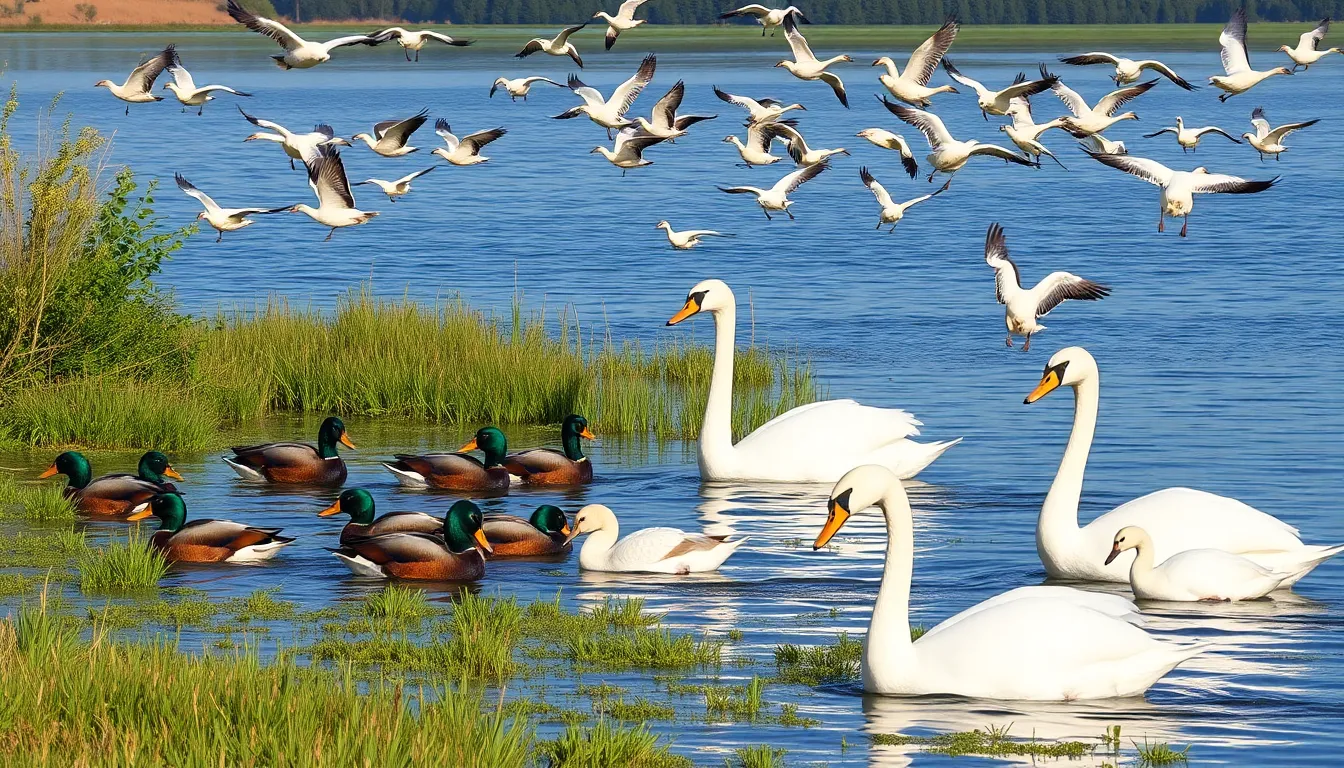
Water environments attract some of our most fascinating bird species. These aquatic habitats support diverse waterfowl populations that have adapted remarkable features for life on and around water.
Ducks and Their Diverse Species Variations
Mallards represent the most recognizable duck species in North America, with males displaying iridescent green heads and females showing mottled brown plumage. These adaptable birds thrive in various water environments, from urban ponds to remote wetlands, feeding on aquatic plants, insects, and small fish.
Wood Ducks showcase stunning coloration with their distinctive crested heads and intricate feather patterns. We often spot these cavity nesters in wooded swamps and marshes where they build their homes in tree holes up to 65 feet above water.
Teal species include Blue-winged Teal and Green-winged Teal, both smaller ducks known for their swift flight patterns. These dabbling ducks prefer shallow waters where they can easily tip forward to feed on seeds and invertebrates without fully submerging.
Canvasback ducks demonstrate exceptional diving abilities, plunging up to 30 feet deep to forage for aquatic vegetation. Their distinctive sloping profiles and reddish heads make them easily identifiable among other diving duck species.
Geese and Their Migration Patterns
Canada Geese follow predictable migration routes called flyways, traveling thousands of miles between breeding and wintering grounds. These large waterfowl form V-shaped formations during flight, rotating leadership positions to conserve energy across their journey.
Snow Geese migrate in massive flocks containing thousands of individuals, creating spectacular wildlife viewing opportunities. We witness their spring and fall migrations as they travel between Arctic breeding grounds and southern wintering areas along coastal regions.
Greylag Geese establish strong family bonds, with parents leading their goslings to feeding areas within days of hatching. These social birds communicate through various honking calls and maintain lifelong partnerships with their mates.
Migration timing varies by species, with most geese beginning their southward journey in September and October. Weather patterns influence their departure dates, as cold fronts trigger large flocks to begin their seasonal movements.
Swans and Their Graceful Movements
Trumpeter Swans represent North America’s largest waterfowl species, with wingspans reaching up to 8 feet across. These magnificent birds require extensive water surfaces for takeoff, needing up to 100 yards of running room to become airborne.
Tundra Swans migrate incredible distances, traveling over 4,000 miles between their Arctic breeding grounds and wintering habitats. We observe their distinctive whistling calls during spring and fall migrations as they pass through wetland stopover sites.
Mute Swans display elegant neck curves and aggressive territorial behaviors, particularly during nesting season. Even though their name, these birds produce various hissing and grunting sounds while defending their aquatic territories.
Swimming techniques among swan species involve powerful webbed feet that propel them gracefully across water surfaces. Their long necks allow them to reach submerged vegetation up to 4 feet deep while maintaining their dignified floating posture.
Exotic Tropical Bird Types From Around the World

Tropical regions showcase some of nature’s most spectacular avian species, featuring vibrant colors and remarkable adaptations that capture our imagination. These exotic bird types demonstrate incredible diversity in their behaviors, intelligence, and physical characteristics.
Parrots and Their Intelligence Levels
Parrots display cognitive abilities that rival those of young children, with African Grey Parrots scoring between 4-6 years old on intelligence tests. We’ve observed these remarkable birds solving complex puzzles, using tools, and demonstrating self-awareness in mirror tests. Amazon Parrots can learn over 100 words and use them contextually, while Cockatoos show problem-solving skills that include opening multiple locks in sequence.
Research studies reveal that parrots possess emotional intelligence, forming lifelong bonds with mates and showing empathy toward other birds. Macaws demonstrate mathematical concepts by counting up to six objects accurately, and they can categorize items by color, shape, and size. Rainbow Lorikeets exhibit social learning behaviors, teaching their young exact feeding techniques and communication patterns through imitation.
| Parrot Species | Intelligence Level | Vocabulary Capacity | Lifespan |
|---|---|---|---|
| African Grey | 4-6 year old child | 100+ words | 50-60 years |
| Amazon Parrot | 3-4 year old child | 80+ words | 40-50 years |
| Cockatoo | 2-3 year old child | 50+ words | 60-70 years |
Toucans and Their Distinctive Beaks
Toucans possess oversized beaks that serve multiple purposes beyond their striking appearance, with some species like the Toco Toucan having beaks measuring up to 8 inches long. We’ve discovered these colorful bills act as sophisticated thermoregulation systems, helping birds release excess heat in tropical climates through increased blood flow to the beak surface.
Keel-billed Toucans use their beaks as precision tools for reaching fruit on branches too small to support their body weight, extending their foraging range by up to 18 inches. Channel-billed Toucans demonstrate remarkable dexterity, manipulating their beaks to crack open tough nuts and extract seeds from deep crevices in tree bark.
Scientific research shows toucan beaks contain a network of blood vessels that can expand and contract, allowing temperature regulation within 2-3 degrees Celsius. Chestnut-mandibled Toucans engage in beak fencing displays during courtship rituals, gently tapping beaks together in coordinated movements that strengthen pair bonds.
Flamingos and Their Unique Feeding Habits
Flamingos filter feed through specialized lamellae structures in their beaks, processing up to 4 gallons of water per day to extract microscopic organisms. We’ve observed these elegant birds using their tongues as suction pumps, creating pressure differences that draw nutrient-rich water through their filtering system at rates of 4-5 times per second.
Greater Flamingos consume blue-green algae, brine shrimp, and small crustaceans that contain carotenoid pigments responsible for their pink coloration. American Flamingos demonstrate communal feeding behaviors, gathering in groups of 50-1,000 birds to stir up sediment and increase food availability for the entire flock.
Lesser Flamingos specialize in filtering diatoms and cyanobacteria from alkaline lakes, with their beaks adapted to process particles as small as 0.1 millimeters. Caribbean Flamingos engage in synchronized feeding movements, creating small whirlpools that concentrate food particles and improve feeding efficiency by up to 40%.
Ground-Dwelling Bird Types and Their Characteristics
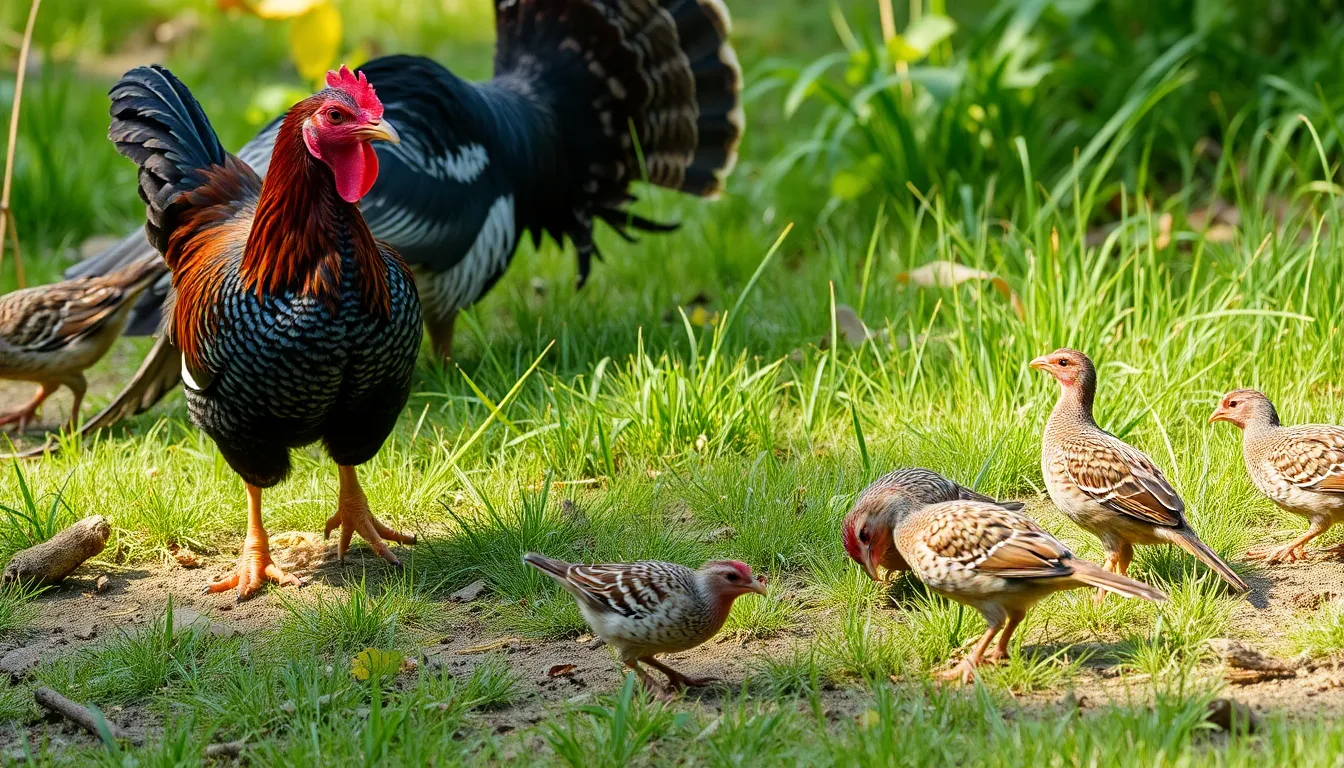
Terrestrial birds represent some of the most fascinating species we encounter, having evolved remarkable adaptations for life on the ground. These ground dwelling bird types showcase incredible diversity in their feeding habits, nesting behaviors, and survival strategies.
Chickens and Their Domesticated Varieties
Chickens originated from wild Red Junglefowl in Southeast Asia and now exist in over 500 distinct breeds worldwide. Heritage breeds like Rhode Island Reds produce 200-300 eggs annually while maintaining excellent foraging abilities. Bantam varieties weigh only 1-2 pounds compared to Jersey Giants that reach 13-15 pounds at maturity.
Selective breeding has created specialized varieties for different purposes including egg production, meat, and ornamental display. Leghorn chickens excel at laying white eggs with hens producing up to 320 eggs per year. Silkie chickens feature unique fluffy plumage and blue-black skin making them popular as ornamental birds and natural incubators.
Free range chickens demonstrate natural ground dwelling behaviors including dust bathing, scratching for insects, and establishing pecking orders within their flocks. These birds spend 60-70% of their active hours foraging on the ground for seeds, insects, and vegetation.
Turkeys and Their Wild Counterparts
Wild turkeys inhabit forests across North America and can fly at speeds reaching 55 mph even though weighing 15-25 pounds. Males display impressive tail fans containing 18 feathers and produce distinctive gobbling calls audible up to one mile away. Their excellent vision allows them to detect movement from 100 yards in any direction.
Domestic turkeys differ significantly from their wild relatives with selective breeding focusing on rapid weight gain and meat production. Heritage breeds like Bourbon Reds and Narragansett turkeys retain flying abilities and natural behaviors. Commercial broad breasted turkeys reach market weight of 38-40 pounds in just 18-20 weeks.
Foraging behaviors distinguish wild turkeys as they scratch through leaf litter searching for acorns, insects, and small reptiles. These ground dwelling birds roost in trees at night but spend daylight hours walking 2-3 miles daily while feeding. Turkey flocks follow established travel routes between roosting and feeding areas throughout their territories.
Quails and Their Camouflage Abilities
Quail species excel at ground camouflage with their mottled brown and gray plumage perfectly matching dried grasses and soil. Bobwhite quails remain motionless when threatened, relying on their cryptic coloration rather than flight to avoid predators. Their feather patterns break up body outlines making detection extremely difficult even at close distances.
Covey formations provide additional protection as 8-25 quails huddle together in circular patterns with heads facing outward. California quails feature distinctive forward curving head plumes and scale like patterns on their underparts. Japanese quails weigh only 3-5 ounces but can run at speeds up to 15 mph through dense vegetation.
Nesting strategies involve creating shallow ground scrapes lined with grass and leaves in areas with overhead cover. Female quails lay 10-16 cream colored eggs with brown speckles that blend seamlessly with surrounding vegetation. Newly hatched chicks leave the nest within 24 hours and follow adults while learning essential foraging and survival skills.
Seabird Types Thriving in Coastal Environments
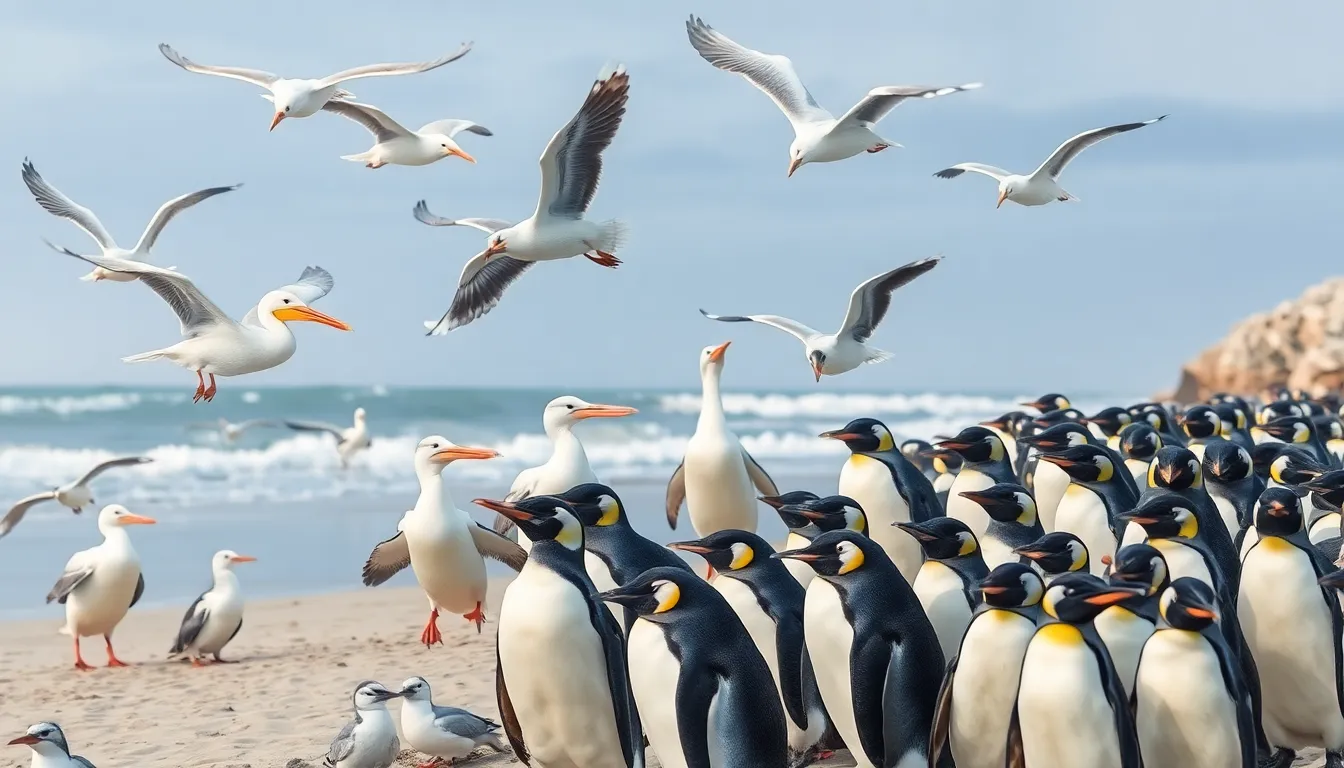
Seabirds represent some of nature’s most specialized avian species, perfectly adapted to life along shorelines and open ocean waters. These remarkable coastal birds have evolved unique features that allow them to thrive in marine environments where land and sea meet.
Seagulls and Their Adaptability
Seagulls dominate coastal environments worldwide with their exceptional adaptability and opportunistic feeding behaviors. These intelligent scavengers possess waterproof feathers and salt glands that filter excess sodium from their systems, allowing them to drink seawater without harm. Ring-billed Gulls, Herring Gulls, and Laughing Gulls represent the most common species we encounter along North American coastlines.
Omnivorous feeding habits make seagulls incredibly successful in diverse environments from beaches to urban areas. They consume fish, crustaceans, insects, and human food scraps with equal enthusiasm. Aerial acrobatics allow them to snatch food mid-flight or jump into shallow waters for prey. Social structures within gull colonies provide protection through communal nesting and cooperative mobbing of predators.
Breeding colonies establish themselves on clifftops, islands, and protected shoreline areas where thousands of pairs nest together. Ground nests consist of grass, seaweed, and debris arranged in shallow depressions. Parental duties are shared between mates, with both adults feeding and protecting their typically 2-3 chicks until they fledge at 6-8 weeks old.
Pelicans and Their Fishing Methods
Pelicans showcase remarkable fishing techniques that have made them master marine hunters across coastal waters worldwide. Brown Pelicans execute spectacular plunge dives from heights of 20-60 feet, folding their wings and hitting the water with tremendous force to capture fish. White Pelicans employ cooperative feeding strategies, forming lines or semicircles to drive fish into shallow waters where they’re easier to catch.
Specialized anatomy supports their fishing prowess through expandable throat pouches that can hold up to 3 gallons of water and fish. Flexible neck joints allow rapid strikes while their streamlined bodies reduce water resistance during dives. Salt glands similar to other seabirds help them process the saltwater they inevitably consume while fishing.
Roosting behaviors find pelicans gathering on piers, rocks, and mangrove trees where they rest between fishing expeditions. Colonial nesting occurs on islands and protected coastal areas where they build platform nests from sticks and vegetation. Young pelicans remain dependent on their parents for 10-12 weeks, learning essential fishing skills through observation and practice.
Penguins and Their Antarctic Lifestyle
Penguins represent the ultimate cold climate seabird adaptation, thriving in some of Earth’s harshest marine environments. Emperor Penguins endure Antarctic winters with temperatures reaching -40°F through dense feather layers and counter-current heat exchange in their flippers and legs. Adelie Penguins, Gentoo Penguins, and Chinstrap Penguins occupy slightly warmer Antarctic and sub-Antarctic regions with their own specialized adaptations.
Swimming capabilities transform these flightless birds into underwater missiles capable of reaching speeds up to 22 mph while hunting krill, fish, and squid. Streamlined bodies and flipper-like wings provide incredible maneuverability underwater where they spend up to 75% of their lives. Diving depths vary by species, with Emperor Penguins reaching depths exceeding 1,800 feet and holding their breath for over 20 minutes.
Social structures revolve around massive breeding colonies where thousands of individuals gather for protection and mate selection. Breeding cycles coordinate with Antarctic seasons, with most species laying 1-2 eggs during the brief summer months. Parental care involves both adults sharing incubation duties and chick-rearing responsibilities, with some species like Emperor Penguins demonstrating extraordinary dedication during the harsh winter breeding season.
Conclusion
We’ve taken you on a journey through the incredible industry of avian diversity from our own backyards to remote tropical forests and vast ocean coastlines. Each bird type we’ve explored showcases millions of years of evolution resulting in perfectly adapted creatures that fill essential ecological roles.
Whether you’re inspired to set up your first bird feeder or plan an international birdwatching expedition these insights will enhance every encounter you have with our feathered friends. The beauty of bird observation lies in its accessibility – remarkable species are waiting to be discovered right outside your window.
Start paying attention to the birds around you and you’ll quickly discover that each species has its own fascinating story to tell through behavior habitat preferences and survival strategies that continue to amaze scientists and enthusiasts alike.
Frequently Asked Questions
How many bird species exist worldwide?
There are over 10,000 different types of birds worldwide, each adapted to various environments and ecosystems. This incredible diversity makes birds one of the most widespread and successful animal groups on Earth, found on every continent including Antarctica.
What are the most common backyard birds for beginners to identify?
The most common backyard birds include Cardinals (known for their bright red plumage), Blue Jays (distinctive blue coloring and intelligence), and American Robins (seasonal indicators with orange-red breasts). These species are easily recognizable and frequently visit bird feeders.
What types of birds of prey are found in North America?
North America hosts three main groups of raptors: Eagles (including Bald Eagles and Golden Eagles), Hawks (such as Red-tailed, Cooper’s, and Sharp-shinned Hawks), and Owls (including Great Horned, Barn, and Screech Owls). Each group has unique hunting strategies and habitat preferences.
Which colorful songbirds are best for attracting to gardens?
Popular colorful songbirds include Goldfinches (brilliant yellow during breeding season), Bluebirds (rebounding populations due to conservation), and Wrens (powerful songs despite small size). These species add both visual beauty and melodious sounds to garden environments.
What waterfowl species live near lakes and rivers?
Common waterfowl include various duck species (Mallards, Wood Ducks, Teal, and Canvasbacks), geese (Canada, Snow, and Greylag Geese), and swans (Trumpeter, Tundra, and Mute Swans). These birds have special adaptations for aquatic life including waterproof feathers.
What makes tropical birds unique compared to other species?
Tropical birds like parrots, toucans, and flamingos display extraordinary intelligence, vibrant colors, and specialized adaptations. Parrots have cognitive abilities comparable to young children, while toucans use their large beaks for thermoregulation and flamingos have unique filter-feeding mechanisms.
What are examples of ground-dwelling bird species?
Ground-dwelling birds include chickens (both domestic and wild varieties), wild turkeys (capable of flight despite their size), and quails (masters of camouflage with covey social structures). These species have evolved specific adaptations for terrestrial life.
Which seabirds are commonly found in coastal areas?
Common coastal seabirds include seagulls (highly adaptable opportunistic feeders), pelicans (skilled fishers with unique diving techniques), and penguins (specialized for cold climates with excellent swimming abilities). These species have adapted to thrive in marine environments.

